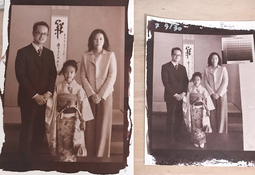Recently, I started making salt prints by contact printing from digital negatives. The attached images are the results. For the sensitizer, I am only using ammonium chloride and distilled water. I plan first to understand salt printing with digital negatives and then challenge myself with printing from wet plate negatives.
About the blurriness (A.jpg)
In the digital negative used, all three people are in focus, but in the print, the face and upper body of the adult woman on the right are blurry. However, her hands do not appear to be out of focus. I applied silver nitrate using a rod, but since it didn't cover the paper completely in one pass, I went over some areas multiple times with the rod. Could this method of application be the cause of the blurriness?
Sharpness difference with sizing (no images attached)
In a different print, I tried applying gelatin sizing to the same paper, expecting sharper results. However, it turned out less sharp than the print without gelatin sizing. Is it possible that sizing could reduce sharpness?
Fixer deterioration (B.jpg)
In the image I attached, the print on the right was fixed on September 30, and the other on the left was fixed on October 5 (today). I haven't used gold toning yet, but there is a noticeable color difference. The fixer (hypo) was made on September 30 and has been used continuously. I’ve processed 11 salt prints, 4x5 inches and 5x7 inches, using 200ml of fixer. Could the color difference be caused by the fixer weakening over time?
I would greatly appreciate any comments from those with experience.
Thank you!
About the blurriness (A.jpg)
In the digital negative used, all three people are in focus, but in the print, the face and upper body of the adult woman on the right are blurry. However, her hands do not appear to be out of focus. I applied silver nitrate using a rod, but since it didn't cover the paper completely in one pass, I went over some areas multiple times with the rod. Could this method of application be the cause of the blurriness?
Sharpness difference with sizing (no images attached)
In a different print, I tried applying gelatin sizing to the same paper, expecting sharper results. However, it turned out less sharp than the print without gelatin sizing. Is it possible that sizing could reduce sharpness?
Fixer deterioration (B.jpg)
In the image I attached, the print on the right was fixed on September 30, and the other on the left was fixed on October 5 (today). I haven't used gold toning yet, but there is a noticeable color difference. The fixer (hypo) was made on September 30 and has been used continuously. I’ve processed 11 salt prints, 4x5 inches and 5x7 inches, using 200ml of fixer. Could the color difference be caused by the fixer weakening over time?
I would greatly appreciate any comments from those with experience.
Thank you!





